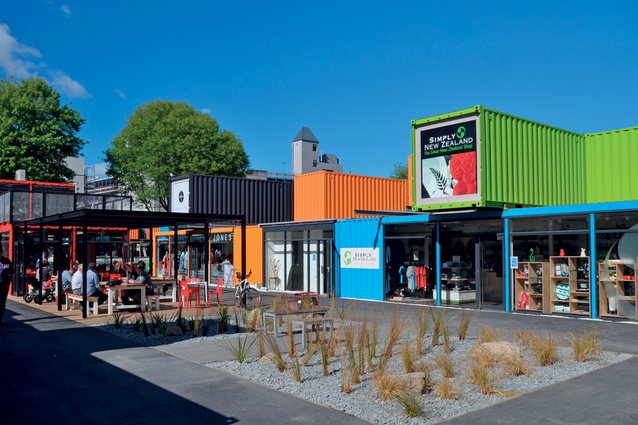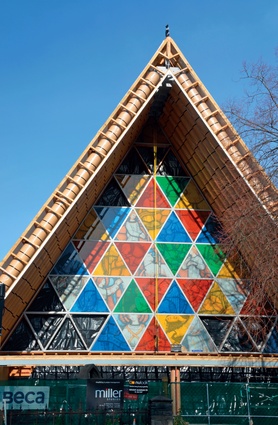Bridging the gap
Wellington-based architect Adam Flowers says temporary construction should play a vital part in the development of permanence, and lead to a more organic process of urban growth.
As well as the tragic loss of life, and extraordinary social upheaval that came out of the Canterbury earthquakes, the sight of a devastated city has shaken our perception of the permanence of our built environment. Images of flattened masonry, failed concrete, buckled steel and twisted timber remain in our consciousness. As I look across Wellington from my office window, the city does not seem as solid as it did before the Christchurch quake. It should be no surprise, of course – through most of human civilisation the vast majority of our buildings have lasted less than one hundred years. A few good ones pass the test of time and endure a few centuries, and only a handful have survived millennia.
Through the twentieth century, however, the way we build has changed. We invest an increasing amount of money and energy into our buildings. Building technology has allowed us to build taller, our buildings are more heavily serviced, and we expect greater durability in our buildings.
I am a strong advocate for building well, and building to last. Public architecture, in particular, requires a long-term view to ensure that the built environment has a quality and permanence that is enduring and can be appreciated by later generations. We should design our major civic institutions with long-life and flexibility in mind.
Such long-term thinking is often underpinned by a conservative approach to design – those involved in commissioning new expensive buildings tend to avoid risk, and lean towards tried and tested solutions. Conversely, when building temporary buildings, one advantage is that owners and architects have more freedom to be explorative and experimental.
As the Christchurch rebuild gains momentum, there have been many temporary and infill design solutions built that have shown an innovation and playfulness that most of the permanent proposals have lacked. Examples such as the Transitional Cathedral, the outdoor performance space and the re:START mall show creativity, dynamism, and a whimsical touch and a lightness of hand that is refreshing and exciting.
Temporary construction can also follow Australian architect Glenn Murcutt’s motto to ‘touch the ground lightly’. Such buildings respect sustainable principles and respond to a sense of the fragility in how we occupy land. Despite being designed as short-lived buildings, many temporary constructions fully embrace environmentally sustainable design. Buildings can be constructed from recycled materials and components. Existing structures can be imaginatively re-inhabited with adaptive reuse. Temporary buildings often make do with less, and have a very small embodied energy footprint. If well designed, such buildings can be recycled, transported, or reused.
Such thinking is not limited to fringe bars, art installations, and performance venues. In 2008 CCM Architects were commissioned to design and document a temporary theatre building for Hutt Hospital to provide operating capacity over a two-year period while their new permanent theatre and emergency department were being built. After looking at other options including leased pods and re-use of containerised army theatres, the temporary theatres were seen as the best value solution. The economic viability of the project required the theatres to be built quickly and cheaply. To complicate matters, the only available location for the theatres was one storey up, above the ambulance bay for the emergency department. We designed a prefabricated building in three transportable sections, with a kitset plant room roof on top.
The project programme allowed less than one year from conception to completion. Prefabrication allowed site works and plant integration to be carried out concurrently with the fabrication of the building itself. By designing the units as transportable sections, the building was able to be easily relocated at the end of its life at Hutt Hospital. Once the permanent theatres were completed, the temporary structure was removed, and has since been transported to Royston Hospital in Hawke’s Bay.
Most of the healthcare projects we work on follow the ‘long-life, loose-fit’ mantra. In this case, however, a short-life, tight-fit design proved to be the best solution to the hospital’s immediate problem. The pre-fabricated construction methodology allowed relocation and re-use, and it is expected that the building will be relocated, recycled, and reused once it has outlived its usefulness in its current location. This project demonstrates how even complex functions can be accommodated in buildings that are nimble and adaptable.
Temporary buildings may also help deliver a better long term built environment for Christchurch. History provides many warnings about the pitfalls and dangers of planned cities, particularly on a large scale. People and businesses have a habit of not doing what utopian designers expect them to do. Whilst there is an obvious opportunity and need in Christchurch at the moment for master-planning and big-picture design, the current framework and precinct plans run the risk of aspirational design not matching social demand - solutions pushed by vision rather than pulled by need. Space needs to be found in the redevelopment of Christchurch for organic design, and for the city to find its own balance. If precincts are to be encouraged, then in my opinion they should be very ambiguous and have very fuzzy edges. Temporary buildings and infill construction can aid a more organic process, and provide immediate amenity, which allows the more permanent city to develop at a slightly slower rate and respond to reoccupation rather than determine it.
We should encourage clients, planners, urban designers and architects to think about temporary solutions more often – not just in Christchurch where the need is obvious, but in our other cities and towns as well. There can be a dynamic contrast between more permanent buildings and short-lived construction. Temporary buildings can help bridge gaps in the city fabric, and can help cities grow more organically. Such developments add vibrancy and activity, and provide examples of how to build with a light touch on a fragile earth.
Adam Flowers is a director of CCM Architects, a Wellington-based practice specialising in healthcare, education, historic refurbishment, residential, commercial and public architecture.











